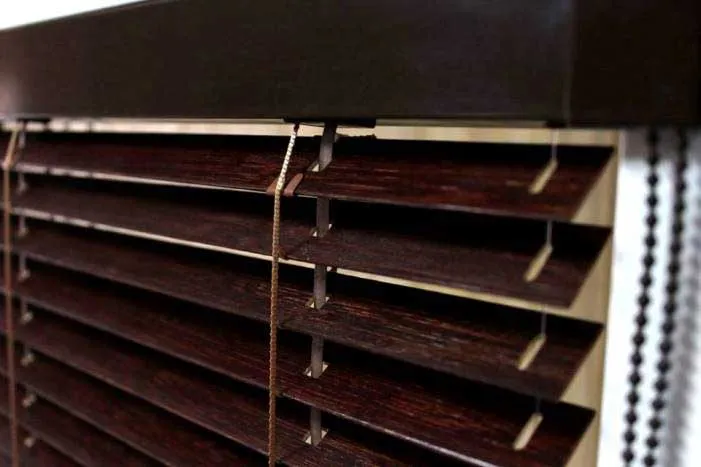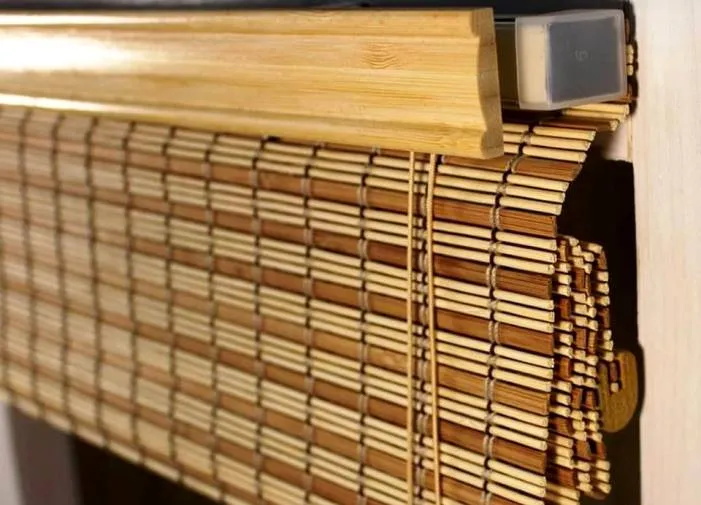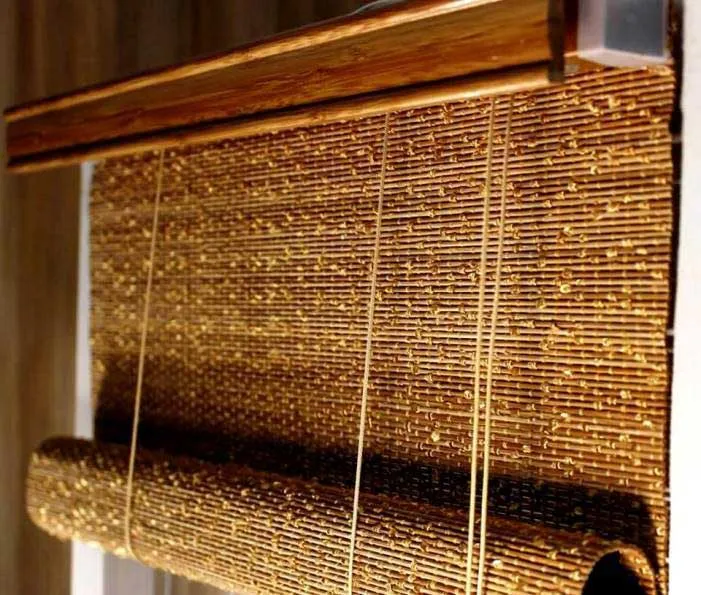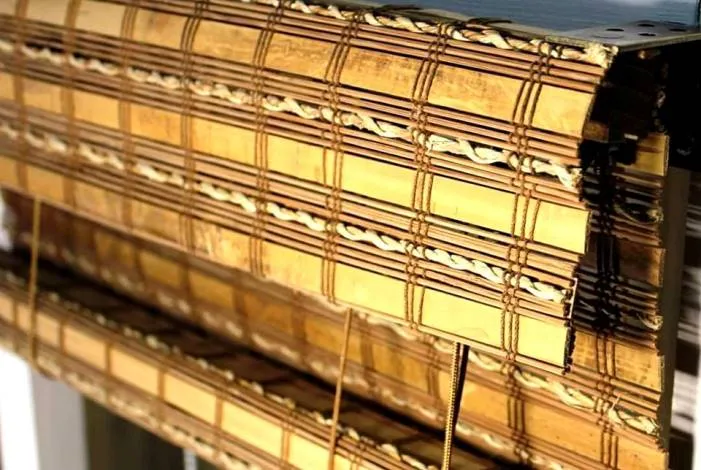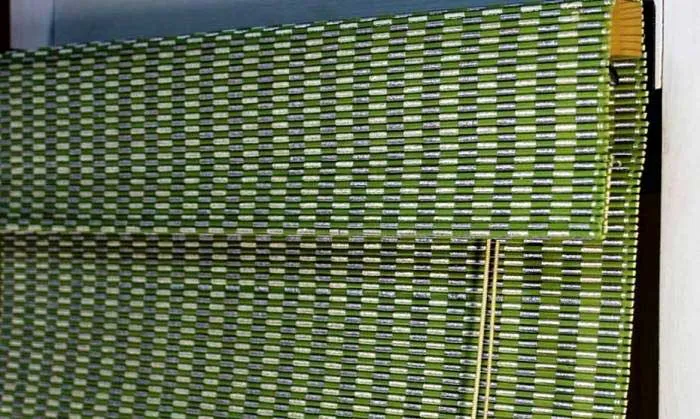Light filters are used to protect the room from sunlight. These systems are not designed to completely block sunlight; they allow light to pass through, gently scattering it around the room, thereby removing glare and protecting furniture from heating by the sun's rays. Light filters come in various shades and can be mounted on plastic, wooden and even aluminum windows. In addition to their visual appeal, light filters are a functional product with varying degrees of light transmission.
Design of filters and their features
Often, roller blinds (also known as light filters) are a thin fabric that is wound on an aluminum shaft, which is fixed at the top of the window. Thanks to special weights and fasteners, the fabric does not flap in the wind, and the curtain fulfills its intended purpose. There are also systems in which the shaft with the fabric is located in a protective aluminum box; such systems are additionally equipped with aluminum guides to ensure the fixation of the fabric, and also hide the side gaps between the frame and the fabric.
All models of light filters are divided into several subtypes:
Open - a roll of fabric is not hidden in anything, hence the name, open systems come in various subtypes and are designed for installation both on small sashes and on panoramic glazing or in offices and shopping centers. Such curtains not only allow you to perform the function of sun protection, but also perfectly zone the space if you need to delimit a large room into separate sections without erecting walls.
Closed - in such systems the fabric is hidden behind a protective box; often such systems are designed for installation on individual sashes or on small window openings. The box limits the available amount of fabric winding, so for particularly long curtains or doors such systems are not always suitable because all the fabric may not fit in the box and the curtain will not be wound entirely.
Attic - Attic systems include both closed and open types with additional fixation, as well as systems with spring mechanisms. The choice of systems for the attic depends on the angle of the windows; in some cases, the curtain will not unwind if the fabric is in a horizontal position.
Materials from which filters are made
Light filters for plastic windows must first of all provide functionality compared to other types of sun protection systems, because if the curtain does not cope with the main function, namely sun protection, then there is no point in using it. Therefore, manufacturers select various materials for light filters in order to provide the widest possible choice in terms of transparency and provide the necessary level of functionality to even the most sophisticated designers.
Fabrics made from natural materials - linen and cotton.
Synthetic fabrics - made of polyester, nylon or PVC.
Natural fabrics - bamboo, jute, straw.
During production, all types of curtains are coated with special antistatic dust-repellent compounds, which protect the fabric from dust, which greatly simplifies the process of caring for curtains. For kitchen curtains, there are also options with antibacterial impregnations, but this applies to natural fabrics; synthetics are often not affected by the environment, so most fabrics are made from 100% polyester. There are also fabrics with a reflective effect, which is achieved thanks to special coatings or lurex threads sewn inside the fabric. Based on the level of transparency, fabrics for light filters can be divided into several types:
Completely transparent - the purpose of such canvases is similar to classic tulle; the curtain gently diffuses the sun's rays and leaves the opportunity to look out the window even when the curtain is closed. In turn, sun protection in such fabrics is low, so curtains can be complemented by a combination with curtains or drapes.
Dimout - most of all fabrics for light filters are made in this series; the curtain not only diffuses sunlight, but also protects from excess heat and partially darkens the room depending on the level of light transmission. These fabrics are the best combination between sun protection and interior decoration; thanks to the wide selection of fabrics with different colors and textures, you can choose curtains for any interior, regardless of the purpose of the room.
Blackout - can be made of thick fabric or with the addition of a rubberized base that does not transmit light. Blackout curtains remain compact and thin, but allow you to completely block the flow of light in the room. A curtain made of fabric marked blackout will be 100% blackout, this applies to both rolled fabrics and the day-night series.
Day-night - belong to a separate type of system, because not only the fabric has significant differences from roller blinds, but also the fittings have undergone changes. In day-night systems, the fabric on the curtain is located in two layers, which are parallel to each other, this allows you to change the ratio of dark and transparent stripes, thereby achieving the effects of “day” or “night”, respectively.
In addition to a large selection of shades and textures, thanks to the structure of the fabric for light filters, you can apply a design to them. The image is printed with a special printer and is not washed off from the fabric during wet cleaning. Thanks to such opportunities, everyone can create a unique curtain for their interior; the fabric acts as a canvas on which you can print your favorite superheroes for curtains in the nursery or Venetian landscapes for the living room or kitchen; with photo printing capabilities you are limited only by your imagination and nothing more.
Accessories for roller blinds may vary depending on the selected system. In mini products for small sashes, mainly plastic fittings are used since the curtain does not experience heavy loads. If the product covers a wide window of about 2 meters in width and height, then special reinforced mechanisms and a thicker shaft in diameter are used to ensure proper operation of the system without wear of components. All minimum and maximum values for system parameters have already been prepared in the calculator on our website, so if you did not receive any warnings when placing an order, you do not have to worry about the performance of the system. Don't worry about missing the notification, the site won't let you place an order with the wrong measurements. In case of notifications, you can change the system to another one or tell our specialists the required dimensions by phone and they will tell you which system is best suited for your windows.
Control mechanisms
Often, all systems use chain mechanisms with the function of fixing the shaft position. This allows you to set the fabric at the required level, and the mechanism will automatically hold it. Such functions are necessary for roller blinds, since often the curtain is partially open to illuminate the room and protect from sunlight. The curtain can also be equipped with a spring mechanism; in this case, there is a special spring inside the shaft that can perform various functions. For example, on roof windows a spring system is used, which always puts a slight force on the fabric in an attempt to wind it onto the shaft, this allows you to install the curtain at an angle without sagging the fabric, but such products cannot be freely hanging and are fixed in special hooks located on the window frame on the sides of the curtain. Another type of spring system is a free-hanging curtain with a self-fixing mechanism. Such products are controlled by a special cord by pulling which the curtain is removed from the clamps and can move in any position. Systems with a spring often do not have the possibility of fixing the “string” since it is not required or is not structurally provided for.
Specifics of installation of light filters
Before installing curtains, you should make sure that the measurements taken are correct and install them in accordance with the measurements. Often, one person does the measuring and installation, since he understands where the fabric will be located and on what principle he used the measurements. Since we are a manufacturer of curtains, we make products according to the specified dimensions, this allows you to close windows of any shape without unnecessary protruding parts of curtains and systems, you get a finished product that will fit your windows because it was made for your windows. Also, manufacturing to size allows you to save on fabric and components, which affects the cost of the product, since you do not overpay for excess fabric and other component parts. Now that we are convinced that the measurements taken are correct, we can proceed to installing the system.
Fastening roller blinds with self-tapping screws
Fixing products with self-tapping screws is the most effective method of fastening roller blinds. Regardless of the profile, be it plastic or wood or even aluminum. Fixation with self-tapping screws allows you to secure the product as efficiently as possible. Since the curtain experiences natural loads (its own weight), as well as when controlling the fabric, the force with which the owner pulls the control chain is transmitted to the mechanisms and gears are transferred into rotation on the shaft with the fabric, which naturally increases the total load on the fastening elements of the product. In this way, both open and closed type systems are attached; the only nuance in closed curtains is the additional use of side guides for the fabric, which are mounted on special double-sided tape. We do not consider the option of attaching products with tape because in the summer the curtain heats up and the tape loses its adhesive properties. As a result, when you try to open the curtain, it may come off, so this installation option is not considered high-quality and safe.
Installation of light filters on a window is carried out in several stages:
The brackets must be attached to the shaft with the fabric and the finished product must be leaned against the window at the place of its future installation. After the curtain is in place, the places where the brackets are attached are marked in width and height; the roller with fabric is no longer needed and can be put aside.
Holes are drilled in the window frame with a drill, after which the brackets are screwed into place. Also, when using small self-tapping screws, the brackets can be secured without first drilling the window frame.
Brackets are screwed onto the frame according to previously installed marks.
On the brackets there are special inserts with gears; one of them needs to be pulled out from either side of the system (pry up the locking ear and the insert comes out towards the edge of the bracket).
One side of the shaft is installed on the remaining bracket with the gear, after which the liner that we took out earlier is placed on the other end of the shaft and, in the reverse order, the liner is placed in the bracket together with the shaft.
After installing the liner, a small decorative plug is installed on the bracket, which hides the hole for the gear.
After installing the product, you need to open and close the curtain several times to ensure correct installation. The fabric should be rolled evenly on both sides; if the fabric is wound more to one side, the product was probably installed at an angle.
Installation of closed systems
Cassette filters go well with plastic windows, regardless of color. The system can be supplied in the following colors: white, brown, golden oak, walnut and mahogany, which corresponds to the standard shades of plastic windows. Therefore, when installing the system, it will be combined with the windows and not stand out against their background. This is a particularly convenient feature if the windows are made to look like wood and a standard white cornice does not look logical.
Closed-type systems are supplied fully assembled, so they are immediately ready for installation.
Before installing the box, it is necessary to fix the guides; for this, the surface of the glazing beads is first degreased for better fixation. You can degrease the glazing beads with any alcohol-based product.
After preparing the glazing beads, it is necessary to remove the protective layer from the guides and glue it to the glazing beads one by one. (the guides are mounted depending on the measurements taken. The height of the curtains for closed systems is indicated as the overall dimension)
After installing the guides, you need to remove the side covers from the box and thereby free the holes in the brackets for fixing the screws.
The box is installed on top of the guides and secured with self-tapping screws to the window frame.
The side covers are returned to their place, after which you can check the functionality of the product.
After installing the system, a chain clamp is mounted next to the control circuit, which holds the chain and prevents it from dangling.
Caring for filters
Even artificial fabrics can accumulate dust from outside or indoors over time. This does not happen as quickly as with natural curtains, but over time the curtain will still be covered with a small layer of dust.
Moisture-resistant fabric from the aqua series or with a rubberized base can be easily wiped with a damp cloth without harming the fabric.
You should initially try to clean polyester without moisture protection without using detergents or excess water, as it can leave streaks on the fabric. If the curtain was in the kitchen and dry cleaning does not help, the curtain can be wiped with a damp sponge soaked in a mild soap solution, and then remove the soap solution with a sponge and clean water. It is not recommended to rub the fabric vigorously, and also to use aggressive cleaning agents so as not to damage the dust-repellent impregnations.
Bottom line
Roller blinds as light filters are an excellent choice as sun protection systems, especially in modern interiors, where products of regular geometric shapes only complement the design and do not make it more official. Light filters are a modern solution in room design; in addition to protecting from the sun, the fabric transmits light through itself, thereby coloring it in its own color. For example, when installing a red or orange curtain, the slopes and the area next to the window will be illuminated with light red or orange light, so with the help of curtains you can adjust the interior to the required shades without directly affecting the furniture. In addition, curtains can always be replaced and added variety; such a solution does not require large financial expenditures and the effect is truly impressive.
